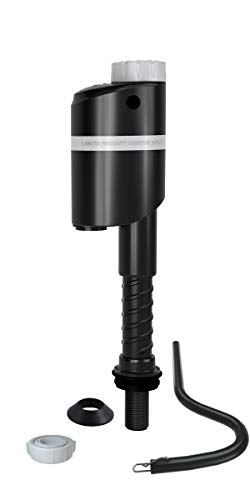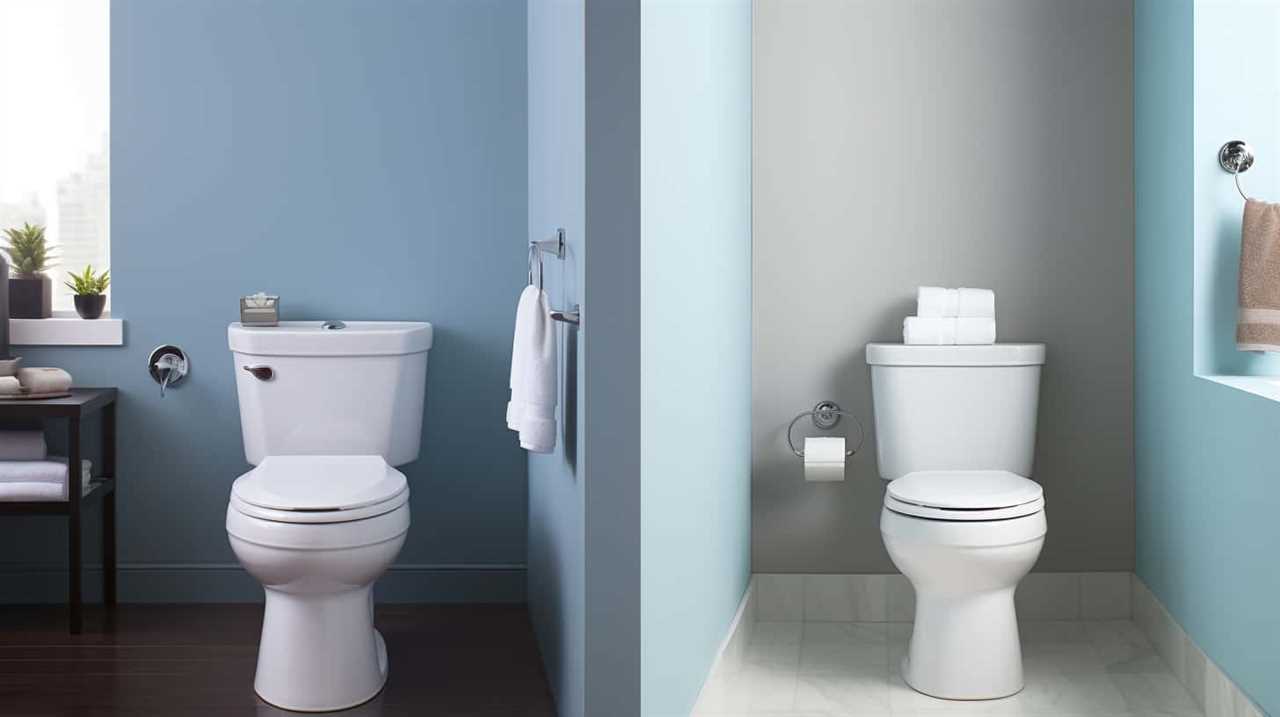Did you know that a running toilet can waste up to 200 gallons of water per day? That’s enough to fill a swimming pool!
If you’re tired of the constant sound of running water and the impact it has on your water bill, then you’ve come to the right place.
In this article, I will share with you step-by-step instructions on how to stop a running toilet. By following these simple tips, you’ll be able to fix the problem and save both water and money in no time.
Key Takeaways
- Inspect the flapper valve for any visible damage or warping and clean or replace it if necessary.
- Check the water supply and ensure it is turned on, with secure connections and no leaks.
- Adjust the float valve inside the tank to maintain the correct water level and prevent overflow.
- Clear any clogs using a plunger and ensure there is enough water in the bowl for effective plunging.
Understanding the Problem
To understand why your toilet keeps running, you need to check the flapper valve.
The flapper valve is a small, rubber piece that sits at the bottom of the toilet tank. Its purpose is to seal off the water flow from the tank to the bowl when the toilet is not in use. If the flapper valve is worn out or not properly aligned, it can cause water to continuously flow into the bowl, resulting in a running toilet.
There are a few common causes for a faulty flapper valve, such as mineral deposits, a damaged chain or flapper, or improper installation. To troubleshoot this issue, start by inspecting the flapper valve for any signs of damage or misalignment. If necessary, clean or replace the flapper valve to resolve the problem.
Now, let’s move on to checking the water supply.
Checking the Water Supply
Make sure you’re checking if the water supply is turned on. When troubleshooting water pressure issues in your toilet, it’s crucial to start with the basics.
Sometimes, a running toilet can be simply caused by a lack of water supply. First, locate the water shut-off valve near the base of the toilet and ensure it is fully open. If the valve is closed, turn it counterclockwise to open it.
Next, check if the water supply line is connected securely to the valve and the toilet tank. Make sure there are no kinks or leaks in the supply line. Additionally, inspect the float valve inside the tank to ensure it is functioning properly.
Adjusting the Float
When it comes to adjusting the float in a toilet, there are a few key points to keep in mind.
First, it’s important to ensure that the float water level is at the correct height. This will help to prevent any water overflow or running toilet issues.
Next, proper float adjustment is crucial for maintaining the proper water level in the tank.
Lastly, by taking the time to adjust the float correctly, you can effectively prevent any potential water overflow and keep your toilet running smoothly.
Float Water Level
Adjust the float to lower the water level in the toilet tank.
Troubleshooting leaks in a running toilet is crucial for maintaining a well-functioning bathroom. Regular toilet maintenance is important to prevent costly repairs and conserve water.
To lower the water level, locate the float inside the tank. It is usually a ball connected to an arm or a cylinder-shaped device. By adjusting the float, you can regulate the amount of water allowed into the tank after each flush. If the water level is too high, it can cause the toilet to continuously run.
Simply bend the float arm downward or adjust the float screw to a lower position. This will help restore the proper water level and prevent any future leaks.
Proper Float Adjustment
To properly adjust the float, you’ll need to locate the float inside the tank. The float is a small device that controls the water level in the toilet tank.
If you are experiencing any issues with the float, such as a constantly running toilet or a toilet that doesn’t fill up properly, it’s important to perform some float maintenance.
First, check for any obstructions or debris that may be preventing the float from moving freely. Clean the float and the surrounding area to ensure smooth operation.
If the float is damaged or worn out, it may need to be replaced. Troubleshooting float issues can be a simple task, but it is crucial for preventing water overflow, which we’ll discuss in the next section.
Prevent Water Overflow
If the water level in the toilet tank gets too high, it can lead to water overflow. To prevent this from happening, it is important to maintain the proper water pressure in your toilet.
High water pressure can cause the tank to fill up too quickly, resulting in an overflow. To regulate the water pressure, you can adjust the water supply valve located behind the toilet. Turn the valve clockwise to decrease the water pressure and counterclockwise to increase it.
Additionally, regular toilet maintenance is crucial in preventing water overflow. Check for any leaks or cracks in the tank and replace any faulty parts immediately. Keeping your toilet in good condition will help prevent any potential water overflow issues and ensure its proper functioning.
Inspecting the Flapper
First, take a look at the flapper to see if it’s causing the toilet to run. Troubleshooting flapper issues is a common step in fixing a faulty flapper.
The flapper is a rubber valve that controls the flow of water from the tank to the bowl. Over time, the flapper can become worn or misaligned, leading to water leaks and a running toilet.
To inspect the flapper, start by removing the tank lid and flushing the toilet. Observe the flapper as it closes after the flush. If it doesn’t close properly or if there are any visible signs of damage, such as cracks or tears, it’s likely that the flapper needs to be replaced.
This is a simple fix that most homeowners can do themselves with just a few basic tools.
Clearing the Clog
Now that I’ve inspected the flapper and determined it’s not the cause of my running toilet, it’s time to move on to the next step: clearing the clog.
A clog can disrupt the proper flow of water, leading to constant running and water wastage. To fix this issue, I will need a plunger.
First, I’ll make sure there is enough water in the toilet bowl to cover the plunger’s rubber cup. If not, I’ll add some water until it’s adequately covered.
Next, I’ll place the plunger over the drain hole and firmly push down, creating a tight seal. Then, I’ll vigorously plunge up and down to create suction and dislodge the clog. This motion should help clear any blockage and restore normal flushing.
Once I’m done, I’ll flush the toilet to see if the clog has been successfully cleared and the running has stopped.
Replacing the Fill Valve
To replace the fill valve, you’ll need to turn off the water supply to the toilet and then unscrew the old valve from the bottom of the tank.
Upgrading technology in the bathroom is essential to ensure everything runs smoothly. When troubleshooting a running toilet, one common issue is a faulty fill valve. This valve controls the water flow into the tank after flushing. If it malfunctions, the toilet may keep running, wasting water and causing frustration.
To replace the fill valve, start by shutting off the water supply valve located behind the toilet. Flush the toilet to drain the tank. Next, use pliers to unscrew the nut connecting the old fill valve to the bottom of the tank.
Install the new fill valve by following the manufacturer’s instructions and reattach the water supply line. Finally, turn on the water supply valve and test the toilet to ensure it’s working properly.
Frequently Asked Questions
How Much Water Does a Running Toilet Waste?
Running toilets waste a significant amount of water, contributing to water conservation concerns. The environmental impact of this wastage is substantial, as precious resources are being used unnecessarily. It’s important to address this issue promptly.
Can a Running Toilet Cause an Increase in Water Bills?
Yes, a running toilet can cause a significant increase in water bills. It wastes a large amount of water, which not only impacts your wallet but also has a detrimental effect on the environment.
Is It Necessary to Call a Plumber to Fix a Running Toilet?
Calling a plumber to fix a running toilet may not always be necessary. Understanding common toilet problems like a faulty flapper or fill valve can help resolve the issue and save on plumber costs.
Are There Any DIY Methods to Fix a Running Toilet Without Using Any Tools?
Sure, there are DIY methods to fix a running toilet without using any tools. One quick fix is adjusting the float valve or flapper. It’s easy and can save you money on a plumber.
How Long Does It Typically Take to Fix a Running Toilet?
To diagnose a running toilet quickly, you need to understand common causes and how to prevent them. It typically takes about 30 minutes to fix a running toilet, but the duration depends on the specific issue.
Conclusion
In conclusion, stopping a running toilet is not as daunting as it may seem. By understanding the problem and checking the water supply, you can make sure the issue is not due to a faulty valve or pipe.
Adjusting the float and inspecting the flapper can also help solve the problem. And if all else fails, clearing a clog or replacing the fill valve may be necessary.
With these practical tips, you can put an end to that pesky running toilet and restore peace and quiet to your bathroom oasis.











